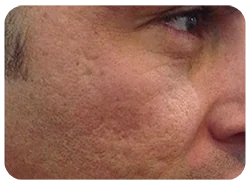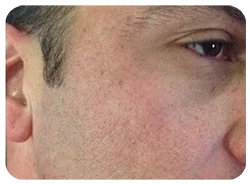Skin Treatments

Freckles are small brown spots usually found on the face, neck, chest, and arms. Freckles are extremely common and are not a health threat. These spots are more common in the summer. They are likely to develop on fair or light skinned people and those with red hair. Freckles are often genetic and can also develop from sun exposure.
A Skin Tag is a small piece of tissue that hangs off the skin. Like Freckles, Skin Tags are not dangerous and are usually found on the neck, chest, back, armpits, under the breasts, or in the groin area. Skin tags are more common in women, especially with weight gain, and in elderly people.
Birthmarks are colored skin spots that either are present at birth or develop shortly after birth. Birthmarks can be many different colors, including brown, tan, black, pale blue, pink, white, red, or purple. Some birthmarks are only colorations of the surface of the skin while others are raised above the surface of the skin.
The cause of birthmarks is still largely unknown.
Avoiding sun exposure can reduce the appearance and frequency of freckles. Maintaining a stable weight and healthy diet may prevent the growth of skin tags, while there is no known way to prevent birthmarks.
Microneedling
View MoreTreatments
Pigment Problems
Changes in the colour of our skin in areas or spots on our face can leave skin uneven and blotchy. Known as hyperpigmentation (dark spot) or hypopigmentation (light spots). These spots are often associated with age but can be brought on by a number of factors.
Causes for pigmentation problems
Skin pigmentation problems affect the color of your skin. Our skin gets its color from a pigment called melanin. When these cells become damaged or unhealthy, it affects the cells ability to produce melanin. Some pigmentation disorders affect just patches of skin. Others can affect the entire body.
Pregnancy, Addison’s disease, and sun exposure can all cause hyperpigmentation leaving skin darker in some areas or spots. Vitiligo and albinism are genetic conditions that cause hypopigmentation (lack of pigmentation).
Skin damage is also a leading cause of pigmentation problems. Infections, blisters, burns and other skin traumas may lead to hypopigmentation in the affected area. As cells aren’t able to form melanin at the same capacity.
If your pigment concern is due to a medical condition like Addison’s or Vitiligo there are some prescription medications that can help treat the condition.
For those with skin damage safeguarding the skin against further damage is key. Avoiding sun exposure can also help reduce the contrast in skin colors. Your doctor may also be able to prescribe a topical cream that can also prevent further damage.
Scars and Stretch Marks
Pregnancy, changes in weight and rapid growth can all lead to stretch marks becoming visible on the skin.
Scarring is often the result of a wound or injury and can be marked with a change in pigment, texture and general appearance.
Causes for Scars and Stretch Marks

Stretch Marks are often associated with pregnancy as the skin grows to accommodate the growing baby the natural elastin is stretched resulting in marks. Whether they are fine skin colored lines, or deep purple bands. Stretch marks can make people feel embarrassed or reluctant to show off their skin. Changes in weight can also cause stretch marks, as well as the rapid growth experienced in adolescence.
Scarring is usually the result of an injury, depending on the way you heal the scar may be lighter or darker than the skin around. The scar may also have a raised or sunken in texture making it noticeable when compared to the rest of the skin.
Treatmwnt for Scars and Stretch Marks
Preventing stretch marks can be challenging however stabilizing your weight can prevent the onset of weight related stretch marks. Moisturizing and hydrating skin can help reduce the appearance and prevalence of stretch marks.
Keeping skin that is affected out of the sun can also prevent stretch marks and scars from darkening and becoming more visible. Dermal rollers have also been recommended in reducing the appearance of stretch marks.
Book your free consultation
If you have a treatment in mind, or would like to discuss available options book a free consultation today and be on the road to the New You in no time.
Sun Damage & Sun Spots
The sun’s rays can be damaging to our skin. Especially if we don’t protect our skin before exposure and moisturizing it afterwards.
Causes for Sun Damage
The damage the sun does to our skin is often referred to by several names. Including photoaging, photodamage, solar damage, or sun damage. It is caused when ultraviolet (UV) light penetrates the skin causing DNA changes at a cellular level. Because sun damage happens in the deepest layers of the skin. The dermis—it can take years before the effects are seen on the outer most layer of the skin.
Once visible sun damage can appear as discolored spots, changes in texture, fine lines and wrinkles. Even moles and freckles and in some cases skin lesions that are cancerous.
Preventing and treating Sun Damage
The best way to protect the skin from sun damage is to limit the amount of sun exposure your skin endures. Gardening or walking in the early morning hours before the sun is its most potent can help reduce the risk of sun damage.
Using a strong SPF on all exposed skin can also prevent the harmful effects of the sun. Sunscreen should also be worn in the winter. Large brimmed hats, sunglasses and covering exposed skin can also mitigate the dangerous effects of the sun.
Have moles, skin lesions and other skin abnormalities examined by a doctor to ensure it is not cancerous.
Financing Options
Click here to find out more about our financing options!













